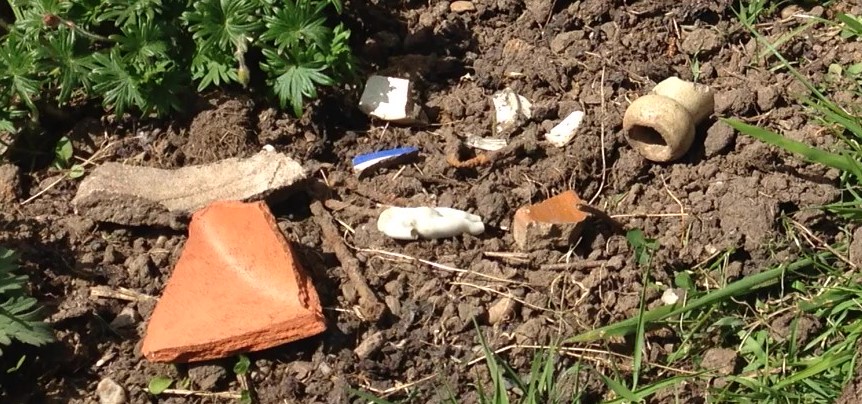
June 10, 2020, by Hannah O'Regan
Frozen Charlotte and the night soil
Have you ever found pottery in your flowerbeds or when out on a walk? You think you’re miles from anywhere, and yet, there’s a little bit of blue & white pottery sticking out by your feet. So how does it get there?
Gardens
In the case of your garden it could be from an old midden or rubbish dump, while the pieces out in the middle of nowhere are probably from night soil. Night soil is a euphemism for poo and urine and all the other contents of sewers. In the modern day, rather than pooing in an outhouse in the garden and throwing broken pots and foodscraps on the kitchen midden, sewers take care of the human waste, and the council bin collectors and the recycling bins at the local supermarkets take care of the rest. In the past, this waste was collected and deposited elsewhere by the night soil men.
Night soil
You may have heard the saying ‘where there’s muck, there’s brass’, as there was money to be made transporting night soil from one place where it was unwanted to another where it made excellent fertilizer. In the 19th century with the invention and expansion of the railways, this trade was at its height. Night soil was collected from cities such as Manchester and transported by railway to land that needed ‘improvement’ (i.e. to make it suitable for farming), or that needed to be reclaimed. In the case of Manchester, a lot of the night soil ended up being distributed on Chat Moss, a large raised bog that lay between Liverpool and Manchester and caused no end of headaches for the engineers who were trying to lay the railway line.

Pottery and oyster shells from night soil, found on Chat Moss near Manchester.
It would be fair to say that Daniel Defoe, writing in 1762 really hadn’t liked it, as he described Chat Moss as “The Surface, at a Distance, looks black and dirty, and is indeed frightful to think of; for it will bear neither Horse nor Man, unless in an exceeding dry season, and then so as not to be travelled over with safety.” (He may have been looking at a very damaged bit though.) A lot of pottery and other waste has been found scattered on Chat Moss, some of which can be seen in the photo.
Frozen Charlotte
You can hear Dr Hannah O’Regan discussing the bits of pottery and nails from her garden (and how they got there) in our YouTube clip, but what’s the story of the small headless doll?
The doll was picked up at Martin Mere, in Lancashire, now a Wildfowl and Wetland Trust Centre, but previously another wetland that was drained and improved in the 19th century. The doll is called ‘Frozen Charlotte’ and she was extremely popular in the mid-late 19th century. The dolls were based on an American poem about a girl who would not wear a cloak to cover her pretty dress during a sleigh-ride to a winter ball, and froze to death on the way (a very Victorian sentiment about not following instructions, vanity, etc…). This Frozen Charlotte would have been a small child’s toy, until she was dropped in the night soil and travelled by cart or train to the mere.
So, the next time you find a bit of pottery in your garden or on a walk, have a good look at it, think how it got there, and perhaps give a nod to the purveyors of the night soil who laboured there in the past.
Further reading suggestions:
On night soil, particularly in London, there’s a great blogpost by the Gardens Trust:
https://thegardenstrust.blog/2015/07/11/night-soil-and-other-euphemisms/
For a fictional look at night soil and the railways: Pratchett, T. (2011) Raising Steam. Transworld Publishers, London. [Starring Harry King, the King of the Golden River (you can guess….)]
Chat Moss and the expansion of the railways: Garfield, S. (2002) The Last journey of William Huskisson: How a day of triumph became a day of despair at the turn of a wheel. Faber and Faber, London.
Chat Moss and Night soil: Wilkinson, D.M., Davis, S.R. (2005) An introduction to Chat Moss. In: Crofts, R.G. (Ed) Quaternary of the Rossendale Forest and Greater Manchester, Field Guide. Quaternary Research Association, London.
For Defoe’s Description of Chat Moss: Defoe, D. (1762) A Tour through the whole island of Great Britain. Divided into Circuits or Journies. Browne et al., London.
No comments yet, fill out a comment to be the first

Leave a Reply